Summary
The manufacture of polymeric materials from their raw form into their final useful product occurs under highly non-equilibrium conditions where temperature and stress fields evolve rapidly and invoke complex non-Newtonian responses in the material. The final properties are dictated by these complex process histories, but they are difficult to measure and control. In this project we develop instrumentation and methodologies for measurement of such fields and the real-time materials response to it. We focus on measurements where national needs have been identified, such as plastics recycling and composite curing, and in emerging areas that represent sources of new U.S. manufacturing, such as additive manufacturing (AM).
Plastics recycling has become a topic of international concern as more attention focuses on ocean pollution, litter, and strained landfills. In this project we examine fundamental issues related to the (re)manufacture of plastics from recycled feedstocks. We focus on polyolefins – e.g. polyethylenes (PE) and polypropylenes (iPP) – as these represent the largest share of such plastic waste. Here we focus on the property reduction that follow when polyolfins are mixed together, which is frequently the case in post-consumer resins. Currently we are examining how they crystallize during processing, and the effect on resulting properties.
Additive manufacturing is a process for fabricating parts directly from 3-D digital models which has tremendous potential for producing high-value, complex, individually customized parts. Companies across the globe are using AM to reduce time-to-market, improve product quality, and reduce the cost to manufacture products. While the use of polymeric materials for AM has been growing, challenges impede its more widespread adoption and commercialization. In many cases, new measurement methods, standards, data, and models are needed to overcome these challenges. We have a particular focus on the rheological and processing aspects of additive manufacturing because their critical importance in the processes. The problems encountered necessitate a thorough understanding of non-isothermal and non-equililibrium kinetics in polymers.
Description
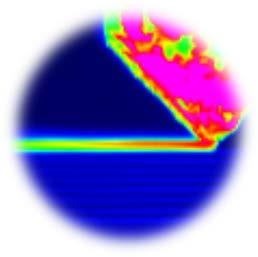
IR thermography measurement of materials extrusion additive manufacturing
We are measuring the fundamental processes and material parameters that are critical to understanding and furthering polymers-based AM. These efforts will aid the AM ecosystem through better online monitoring capabilities and developing strategies for materials optimization.
- In situ measurements of the critical processes that occur in polymers in extrusion based additive manufacturing and recycling. We are developing in situ measures of temperature, stress and crystallization for creation of models that incorporate rheology and process parameters. This will enable direct feedback approaches during processing/printing, quality assurance schemes and strategies for optimization of materials and processes.
- Flow Induced Crystallization (FIC) of Polymers and Nano-composites: It is long known that flow can dramatically increase the crystallization rate of molten polymers, but a molecular description of the underlying reason is still lacking. The ability to predict and control FIC may be critical to effective welding of semi-crystalline polymers and their composites in 3D printing. We are developing instrumentation and models to understand how the crystallization rate is changed by the 3D printing environment and the ultimate effect on part strength. We have developed the rheo-Raman microscope in support of these objectives.
Major Accomplishments
Plastics Recycling
We employ the NIST rheo-Raman-microscope, a hybrid instrument which is capable of simultaneous measurement of the crystallization kinetics and the rheology during the cooling from molten polymer to its solid form. Our goal is to use these measurements to improve the strength of recycled plastics and better understand mechanical properties including tensile stress, compressive stress, thermal properties, and nanostructure. We have observed a strong dependence of composition on the crystallization process, a phenomena we attribute to finite size effects, morphology and partial miscibility.
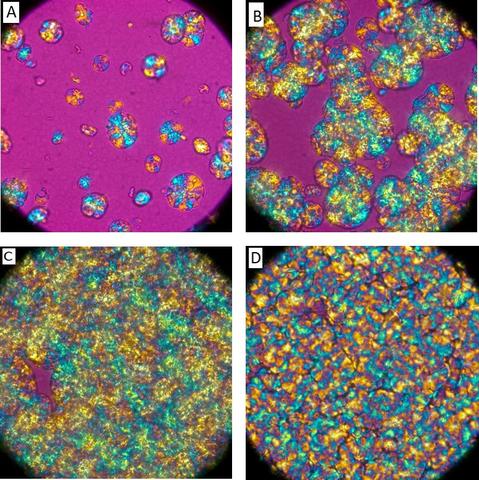
Conventional extrusion-based 3D printing methods require inks that are self-supporting. By submerging the print nozzle into a viscoelastic support bath, embedded 3D printing allows for lower-viscosity inks which would otherwise slump and flow onto a substrate. With promising applications in bioprinting of soft tissues, organoids, and organs, embedded 3D printing enables the fabrication of soft, complex, custom structures. However, in order to produce high-quality, reliable prints, we need to understand why defects form. Filament defects including sharp edges, roughness, rupture, contraction, and swelling can lead to poor mechanical properties or compositional impurities in final parts. Inter-filament defects including poor fusion and deformation of written structures can lead to inaccurate printed shapes and poor mechanical and functional properties. Using numerical simulations in OpenFOAM and in-situ imaging experiments on a custom embedded 3D printer, we identify guidelines for ink compositions, support compositions, and printing parameters which improve print quality.
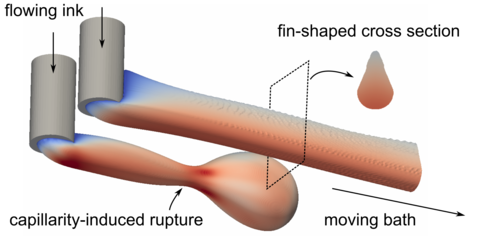
Fundamentals of the materials extrusion 3D printing process
In the common thermoplastic additive manufacturing (AM) process known as materials extrusion (FFF), a solid polymer filament is melted, extruded though a rastering nozzle, welded onto neighboring layers and solidified. We developed a framework to measure and understand the physical processes that underly this 3D printing process. Our framework centers around three interrelated components: in situ thermal measurements (via infrared imaging), temperature dependent molecular processes (via rheology), and mechanical testing (via mode III fracture). We developed the concept of an equivalent isothermal weld time and test its relationship to fracture energy. The results of these analysis provide a basis for optimizing inter-layer strength, the limitations of the ME process, and guide development of new materials.
Temperature measurements, the temperature of the polymer at each stage is the key parameter governing these non- equilibrium processes, but due to its strong spatial and temporal variations, it is difficult to measure accurately. We utilized IR imaging - in conjunction with necessary reflection corrections and calibration procedures - to measure these temperature profiles of a model polymer during 3D printing. The resulting temperature profiles and resultant mechanical properties yield great insight into the fundamental kinetics of the welding process and provides direct data to directly input into theoretical models.
Mechanical properties, we developed a mode III fracture test whereby by we print a wall which is one "road" wide. With this geometry, the fracture plane occurs at a point where we have taken our IR temperature measurements, thus allowing a direct comparison between weld strength and the temperature profile. We work with theorists and modelers from Georgetown University, Johns Hopkins, U Mass (Lowell) and University of Texas (Arlington) to predict mechanical strength based on the rheology, molecular considerations and temperature profile.
Current work focuses on molecular weight dependence on bringing additional novel measurement capabilities online.
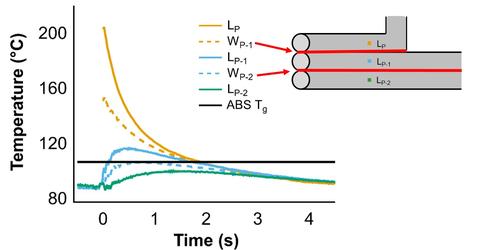
The rheo-Raman-microscope We developed a novel combination of instruments —called the rheo-Raman microscope- that integrates a Raman spectrometer, a rotational rheometer and an optical microscope. This instrument will be utilized to measure the behavior of polymers under conditions of rapid flow and temperature changes, such as those that occur in additive manufacturing. Knowledge from these measurements will be utilized in modeling and characterizing the 3D printing process. This device has now been commercialized by several major vendors of torsional rheometers. See Press Release and publications link (below). The rheo-Raman-microscope will have uses in understanding kinetic processes by linking rheolgy to chemistyr and conformational changes. Applications include curing, reactive blends, gelation, crystallization and emulsions.
We have utilized the rheo-Raman-microscope to address longstanding questions in polymer crystallization. In particular, the functional relationship between modulus and crystallinity during the crystallization process had been unclear because simultaneous measurements of these measureands has hitherto been impossible. With our device, we were able to make such measurements and to propose a model based on a suspension mechanics that incorporates a percolation transition. Current work includes understanding the full frequency dependence of the modulus-crystallinity relationship, and also in understanding the role of spherulites in the percolation process.
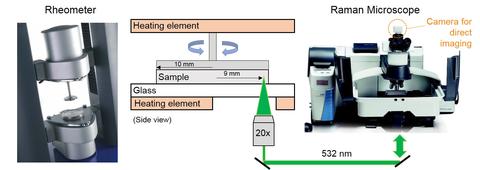
AM Bench
AM-Bench is developing a continuing series of controlled benchmark tests, in conjunction with a conference series, with two initial goals, 1) to allow modelers to test their simulations against rigorous, highly controlled additive manufacturing benchmark test data, and 2) to encourage additive manufacturing practitioners to develop novel mitigation strategies for challenging build scenarios. We organized the polymers component of AM Bench.
See: https://www.nist.gov/ambench
Measurement Science Roadmap for Polymer-Based Additive Manufacturing
In June of 2016 we co-sponsored a workshop with NSF on polymer-based AM to develop a roadmap that identifies the primary challenges in polymers additive manufacturing from the perspective of measurement science.
Click here for the workshop web page which includes links to the meeting presentations.
The final workshop report can be found here: https://doi.org/10.6028/NIST.AMS.100-5
Project Publications
2023
- Characterization of Die-Swell in Thermoplastic Material Extrusion (Additive Manufacturing)
- Simultaneous rheology and cure kinetics dictate thermal post-curing of thermoset composite resins for material extrusion (Additive Manufacturing)
- Reaction-Induced Phase Separation (RIPS) in Amine-Cured Epoxy/Epoxy Thermosets.2. Visualization of Heterogeneity using Fluorescence Lifetime Imaging Microscopy (FLIM) (Polymer)
- Mechanical Regulation of Oral Epithelial Barrier Function (Bioengineering)
- Trace Water Effects on Crystalline 1-Ethyl-3-methylimidazolium Acetate (Journal of Physical Chemistry B)
- Simultaneous rheology and cure kinetics dictate thermal post-curing of thermoset composite resins for material extrusion (Additive Manufacturing)
- Connecting Molecular Exchange Dynamics to Stress Relaxation in Phase-Separated Dynamic Covalent Networks (ACS Macro Letters)
2022
- Suppression of filament defects in embedded 3D printing (ACS Applied Mater Interfaces)
- Simulated stress mitigation strategies in embedded 3D bioprinting (Physics of Fluids)
- Numerical Investigation of Tear Testing of a Single Weld Formed by Fused Filament Fabrication
- Characterization of Die-Swell in Thermoplastic Material Extrusion (Additive Manufacturing)
- Engineering 3D Printed Scaffolds with Tunable Hydroxyapatite (Journal of Functional Biomaterials)
- An Assessment of Mass Balance Accounting Methods for Polymers Workshop Report
- Crystallization Kinetics in an Immiscible Polyolefin Blend (Macromolecules)
2021
- AMB2018-03: Benchmark Physical Property Measurements for Material Extrusion Additive Manufacturing of Polycarbonate
- Estimations of the effective Young's modulus of specimens prepared by fused filament fabrication (Additive Manufacturing)
- Comparing Polarized Raman Spectroscopy and Birefringence as Probes of Molecular Scale Alignment in 3D Printed Thermoplastics (MRS Communications)
- Fabrication of 3D Printed Hydroxyapatite Composite Scaffolds for Bone Regeneration (Biomedical Materials)
- Simulated filament shapes in embedded 3D printing(Soft Matter)
- Solvent-cast 3D Printing of Biodegradable Polymer Scaffolds (Macromolecular Materials and Engineering)
2020
- A frequency-dependent effective medium model for the rheology of crystallizing polymers (Journal of Rheology)
- Effects of feed rates on temperature profiles and feed forces in material extrusion additive manufacturing (Additive Manufacturing)
- Upper bound of feed rates in thermoplastic material extrusion based additive manufacturing (Additive Manufacturing)
- 3D printed optical concentrators for LED arrays (OSA Continuum)
- Processing-Structure-Property Relationships of Polycarbonate Samples Prepared by Fused Filament Fabrication (Additive Manufacturing)
- Compressive deformation analysis of large area pellet-fed material extrusion 3D printed parts in relation to in situ thermal imaging(Additive Manufacturing)
2019
- BOOK: Polymer-Based Additive Manufacturing: Recent Developments. ACS Symposium Series #1315
- Including NIST authored chapters: Polymer Additive Manufacturing: Confronting Complexity (Chapter 1), Measuring & Predicting Crystal Morphology in Fused Deposition Modeling (Chapter 6)
- Rheology of crystallizing polymers: The role of spherulitic superstructures, gap height, and nucleation densities (Journal of Rheology)
- Mechanisms of spontaneous chain formation and subsequent microstructural evolution in shear- driven strongly confined drop monolayers (Soft Matter)
- Precision, Tunable Deuterated Polyethylene via Polyhomologation (Journal of the American Chemical Society)
- Outcomes and Conclusions from the 2018 AM-Bench Measurements, Challenge Problems, Modeling Submissions, and Conference (Integrating Materials and Manufacturing Innovation)
- AMB2018-04: Benchmark Physical Property Measurements for Powder Bed Fusion Additive Manufacturing of Polyamide 12 (Integrating Materials and Manufacturing Innovation)
2018
- Effect of processing conditions on crystallization kinetics during materials extrusion additive manufacturing (Polymer)
- Effect of cellulose nanocrystals on crystallization kinetics of polycaprolactone as probed by Rheo-Raman (Polymer)
2017
- Weld formation during material extrusion additive manufacturing (Soft Matter)
- Evaluating models for polycaprolactone crystallization via simultaneous rheology and Raman spectroscopy (Journal of Rheology)
- Determining conformational order and crystallinity in polycaprolactone via Raman spectroscopy (Polymer)
- Mechanical strength of welding zones produced by polymer extrusion AM (Additive Manufacturing)
- Raman Identification of Multiple Melting Peaks of Polyethylene (Macromolecules)
2016
- Infrared thermography of welding zones produced by polymer extrusion additive manufacturing (Additive Manufacturing)
- Rheo-Raman Microscope: Simultaneous chemical, conformational, mechanical, and microstructural measures of soft materials (Review of Scientific Instruments)
- Phase-specific Raman analysis of n-alkane melting by moving-window two-dimensional correlation spectroscopy (Journal of Raman Spectroscopy)
- Lightweight, flexible, high-performance carbon nanotube cables by scalable flow coating (Applied Materials and Interfaces)
2014-15
- Trans-Rich Structures in Early Stage Crystallization of Polyethylene (Macromolecules)
- Three Dimensional Cluster Distributions in Processed Multi-wall Carbon Nanotube Polymer Composites (Polymer)

